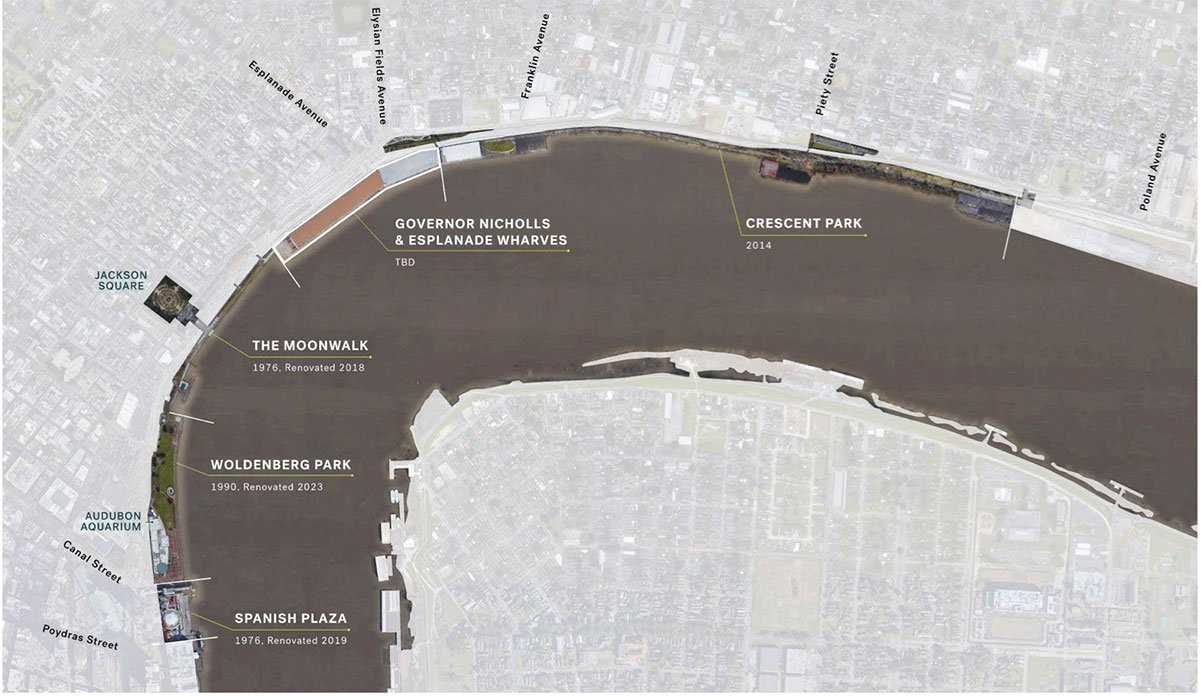Three Decades of Activism, One New Riverfront Park
Nathan Chapman, president of Vieux Carré Property Owners, Residents and Associates, has been involved for more than 30 years in the usage of the Governor Nicholls and Esplanade Street wharves at the edge of the French Quarter.
April 2024Unrelenting advocacy over two wharf sites scores what appears to be a win for New Orleans residents while helping protect two of the most fragile neighborhoods in the country: the French Quarter and Faubourg Marigny.
– by Frank Perez
portraits by Ellis Anderson, graphics courtesy Audubon Parks presentationThe French Quarter has long been a case study in residential versus commercial interests in historic communities. The latest battle in that century-long struggle is the redevelopment of the Governor Nicholls and Esplanade Avenue wharves. Now it seems that preservationists and neighborhood residents may have won the latest fight on what to do with the riverfront property where the once thriving wharves are located.
With the rise of tourism as an industry over the last several decades, the riverfront at the French Quarter has been transformed. The Moonwalk in front of Jackson Square dates to 1976 and underwent a major renovation in 2018. Spanish Plaza opened in 1976. Woldenberg Park dates to 1990, and Crescent Park (fronting the Marigny and Bywater) opened in 2014.
Rendering courtesy of Audubon Parks / EskewDumezRipple / Hargreaves Jones – “Riverfront for All” presentation
Gone are all the wharves and dockworkers and stevedores and longshoremen and sailors that gave rise to the seedy strip that was Decatur Street. Bars like La Casa de los Marinos and Acropolis and Jewel’s have been replaced with restaurants and gift shops. The only vestige of those heady days are the Governor Nicholls and Esplanade Avenue Wharves.
The New Orleans riverfront, 1903, photo Library of Congress
Repurposing the wharves has been debated for over 30 years, beginning even before the opening of the Audubon Institute’s Aquarium in 1990. The aquarium itself was not without controversy. Preservationists and neighborhood advocates vigorously opposed the aquarium, arguing its contemporary design would not fit in the neighborhood and that the attraction would add stress to a neighborhood already feeling the burdens of overtourism.
Attorney Jim Logan and Nathan Chapman, who worked for passive use of the lower Quarter/Marigny wharf areas for many years.
After the Aquarium was opened, Audubon proposed another massive project at the other end of the Quarter—an insectarium at the Governor Nicholls Wharf. Preservationists and residents rallied in opposition. Nathan Chapman, current president of the Vieux Carré Property Owners, Residents and Associates (VCPORA), and attorney Jim Logan led the opposition effort.
Logan, a longtime resident of the city’s Carrollton neighborhood Uptown and at that time a board member of VCPORA in its “associate” category (meaning he didn’t live or own property in the French Quarter), said his robust activism on behalf of the neighborhood has been driven by his understanding of the Quarter’s importance to the city as a whole.
“We all need to care about what happens in the Quarter,” he said.
In a recent letter to VCPORA members, Nathan Chapman – who’s been involved since the beginning debates on the wharf usage, shared some of the battle’s history.
I first began volunteering with VCPORA (in those days we called it “the Property Owners”) at the beginning of the 1990s. The organization had just been trounced in its opposition to a modernistic aquarium in the historic French Quarter near Canal Street.
It’s fair to say that our board was demoralized and, frankly, feeling hopeless. Audubon appeared invincible as it moved from developing one end of the Quarter’s edge to the other.
With the Insectarium’s attendance projected to be a half-million visitors per year, our organization feared traffic, as well as tourists taking up parking needed by residents. We feared homes being rezoned for commercial uses, as thousands of tourists were to be drawn to the more residential “lower Quarter.”
We objected to the inappropriateness of another large, tourist money-maker on the French Quarter’s riverfront. We pleaded, “Why distract from the magnificent views of the Mississippi River with another tourist attraction?” We kept asking for a simple, “passive park” as a place to enjoy the River.
After a five-year fight – and against the odds – VCPORA won that battle. But it was only the first of many. Over the years, other proposals for the site have included an outdoor amphitheater, a Ferris wheel, high rises, and a café featuring helium balloon rides.
VCPORA Executive Director, Erin Holmes, with a few of the many files the organization has kept over the last thirty years on proposals for the Governor Nicholls and Esplanade Street wharves.
Over the years, many other community and preservation groups, including the Faubourg Marigny Improvement Association, Louisiana Landmarks Society and French Quarter Citizens have worked with VCPORA to protect the Governor Nicholls and Esplanade wharf areas from inappropriate development. In a recent interview, Chapman explained why the issue galvanized community advocates:
“The Vieux Carré is not just a historic district - it’s a federally designated landmark, right up there with George Washington’s Mount Vernon and Philadelphia’s Independence Hall,” Chapman said.
“You wouldn’t expect to see Ferris wheels, amphitheaters and the world’s largest insectarium at those landmarks. Nor are they appropriate in the French Quarter.”
Graphic from a 2014 proposal for the wharf area.
French Quarter and Marigny Riverfront Issues Timeline, 1946 - 2024
In 2018, the Audubon Institute raised the issue of redevelopment again. Discussion of the proposal via public meetings and planning was interrupted by the pandemic but has recently resurfaced.
After much debate and discussion, on February 23, 2024, the New Orleans City Council approved a plan to redevelop the Governor Nicholls and Esplanade Avenue wharves. This particular Audubon Institute plan calls for a passive park and for the first time in 34 years, neighborhood advocates are not opposing the proposal and even cautiously supporting it.
The project, which is being designed by New Orleans architecture and urban planning firm EskewDumezRipple in collaboration with landscape architect Hargreaves Jones, will result in additional green space, concession venues, and the long-awaited connection of Crescent Park (which the same design team completed in 2014) to the rest of the riverfront.
Rendering courtesy of Audubon Parks / EskewDumezRipple / Hargreaves Jones – “Riverfront for All” presentation
Rendering courtesy of Audubon Parks / EskewDumezRipple / Hargreaves Jones – “Riverfront for All” presentation
In 2018, the Audubon Institute estimated the cost of the park at $15 million and had secured that funding. But that figure doubled after the pandemic. Mayor Cantrell says she supports the project but has failed to commit to funding it. The City Council recently approved a city bond measure to supply the additional $15 million. Completion of the project is expected to last two years once construction begins.
While questions still remain regarding the park’s sustained maintenance, proposals to create another major attraction at the site to cover the cost have evaporated for the time being. Community advocates for the Quarter and Marigny are encouraged.
Rendering courtesy of Audubon Parks / EskewDumezRipple / Hargreaves Jones – “Riverfront for All” presentation
Rendering courtesy of Audubon Parks / EskewDumezRipple / Hargreaves Jones – “Riverfront for All” presentation
“VCPORA believes that the French Quarter is already an incredible revenue generator,” said Chapman, “so we shouldn’t face the burden of another large attraction just to pay for a new park to be enjoyed by the whole city and arguably the world. The current proposal – if followed – finally presents a riverfront park with no large attractions.
“We’re an internationally famous destination that benefits the entire state,” he continued. “We should nurture the Quarter, not exploit it. That means we protect it from Coney Island-like distractions, excessive sound levels, and overtourism.”
VCPORA was first organized in the 1920s and was incorporated as a non-profit in 1938. Many of the current issues the group deals with are those spawned by overtourism, now a worldwide problem. In 2019, the city hosted nearly 20 million visitors and just last year, 17.5 million came.
While tourism leaders project continued growth, the question for sustainable tourism advocates is how much is too much? When will the infrastructure buckle? When does quality of life for residents become negatively impacted and start to drive residents away? VCPORA is in the process of producing a documentary on overtourism that looks at the issue in-depth.
VCPORA is working on a documentary about overtourism, click here to learn more. Image courtesy VCPORA
One of the chief claims of sustainable tourism advocates is that tourism must be managed as well as marketed. In a 2020 article, writer Rosie Spinks notes, “It seems almost quaint to think that, not too long ago, the job of tourism boards and destination marketers could be described so simply: Get more people to visit your destination…
“Measuring success by swelling visitor numbers no longer feels relevant. The holy grail of a sustainable yet lucrative tourism industry has, by definition, come to mean tourism that local residents and stakeholders feel good about too.
“Destinations that are to remain competitive and attractive to visitors for years to come will have to start protecting their communities and cultural capital now.”
While the current proposal for a park seems to be a reasonable way to balance residential and commercial concerns, Chapman says French Quarter advocates are remaining vigilant.
“The devil is always in the details. How often [will the park host large entertainment events]? What hours? What sound mitigation tools and techniques will be used?”
Stakeholders will be meeting with Audubon next week to begin hammering out some of those devilish details. Chapman and advocates from other neighborhood and preservation groups will be holding fast to their three-decade goal of protecting the best interests of the French Quarter and the Marigny communities.
“It’s a cliché to say that the Quarter is a golden goose for New Orleans,” says Chapman. “But many clichés are grounded in truth. This is one of them.”
Rendering courtesy of Audubon Parks / EskewDumezRipple / Hargreaves Jones – “Riverfront for All” presentation
Your donations make stories like this one possible:













